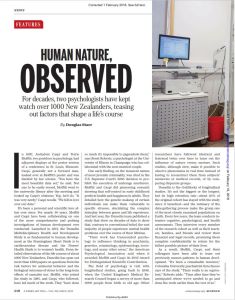Join getAbstract to access the summary!

Join getAbstract to access the summary!
Douglas Starr
Human Nature, Observed
For decades, two psychologists have kept watch over 1,000 New Zealanders, teasing out factors that shape a life’s course.
Science, 2018
What's inside?
How much of your life could have been predicted by neurological testing at age 3?
Recommendation
Since 1972, more than 1,000 New Zealanders have donated their time and data to the Dunedin Multidisciplinary Health and Development Study, helping researchers disentangle the influences that touch a human life. Violence, mental disorders, poor health and early aging: Have the forces that predispose people to these fates been jogging invisibly beside them since the beginning? If so, can they outrun the demons that inhabit their DNA? getAbstract recommends this article to legislators, those who make public policy and anyone who wants a better understanding of human health, behavior and destiny.
Summary
About the Author
Douglas Starr is the co-director of the Graduate Program in Science Journalism at Boston University. He has covered science, medicine and crime in diverse publications and several books, including The Killer of Little Shepherds.


















Comment on this summary